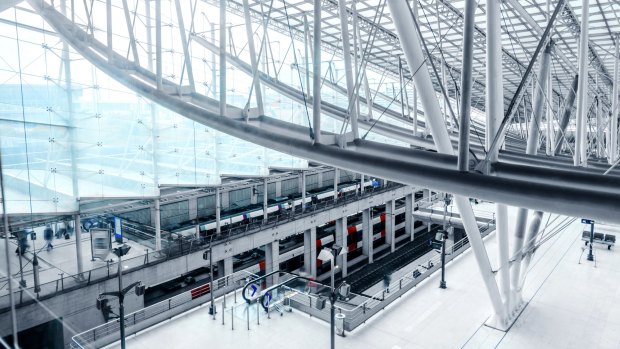This was published 7 years ago
Paris' Charles de Gaulle airport: What the world's hub airports could learn from the French
By George Hobica

Over 30,000 passengers are reported to pass through Charles de Gaulle airport each year.Credit: iStock
Love them or hate them, hub airports are here to stay. Although many passengers prefer non-stop flights, hub and spoke systems allow airlines to offer more destinations and routes, resulting in lower airfares. That's because while there might not be enough demand for four or five airlines flying a non-stop route between any two given points, with the hub airport model several airlines can compete between those two airports through their various connecting points while still earning a profit.
Some airlines were later than others to the hub concept, but that may have allowed at least one of them to put in place best practices that even the more snazzy airports in the Middle East and elsewhere lack.
Paris' Charles de Gaulle (CDG) is one such late-comer innovator.
Twenty years ago, CDG airport saw barely 1000 connecting passengers daily; now there are over 30,000, according to Augustin de Romanelli, the CEO of the group that operates CDG, Aeroport de Paris.
Although it's a relatively recent hub airport, it now offers competitive advantages, as a recent visit demonstrated, and other hub airports could learn a thing or two from the French.
See also: Paris airport opens I Love Paris transit-only restaurant
For instance: All signage is in Chinese as well as English and French to accommodate an expected surge in visitors from mainland China. The airport offers a free lounge for all connecting passengers, not just those flying in business and first class. CDG's "Instant Paris" lounge includes a library, spacious lounge areas with luxurious seating, and copious electrical outlets accepting European, US, British and USB plugs and voltages (no adapters needed!). An adjacent, new short-stay 84-"cabin" Yotel hotel, opened in late 2016, includes family rooms for two children and two adults as well as accessible accommodations, for short stays. Speaking of lounges, CDG had six free kids-only lounges to coddle the 250,000 unaccompanied minors who transit through each year. Equipped with day beds, foosball tables, Playstation consoles, a snack bar, games, toys, books, and other amenities, this unique feature attests to Air France's and the airport's commitment to distinguish itself from competitors.
If you've ever had to go through security again while making a connection, this is quite brilliant: CDG added transit "tubes" that allow passengers to reach connecting flights quickly while staying in "sterile" areas, eliminating the need for additional security checks between flights.
Self-boarding is another concept I'd like to see at more airports. Anyone flying these days at major US hub airports has experienced the chaos of boarding procedures (American now has nine different boarding groups; United makes people line up in separate boarding rows by group number). At CDG, Air France has installed self-service gates that allow the boarding passes of all 178 passengers on an Airbus A320 to be scanned in 12 minutes or less. I tested this recently at it does indeed take about 10 minutes to board. Long passport control lines can also be a hassle. CDG is developing facial recognition software and hardware to compare passport photos with travellers' faces, which will make immigration control faster and, just as important, more secure (a little-appreciated fact is that a certain percentage of the population is sufficiently face blind, including presumably some immigration officials, that facial recognition software is a safer way to match passport photos with faces).
See also: The world's best airport for 2017 named at annual awards
One thing that's missing at all three New York airports and many others is a high-speed train linking terminals and the city. A new high-speed CDG Express train is in the works, with 20-minute travel times to Paris' Gare de l'Est. Speed is important to connecting passengers, so Air France employees at CDG now carry tablet computers (2500 of them to be exact), as I discovered on a recent trip. Presenting myself at check-in, an employee found my reservation as I approached, noticed that I had "Sky Priority" and directed me to an expedited line. With four runways, CDG has a lot of room for expansion, Franck Turner, Air France's CEO, boasted recently. He also claims that CDG now hosts more international connections than does London Heathrow (it also has twice as many runways, he notes with typical French pride).
There are many innovative airports around the world, most of them hub operations. The super hubs that have sprouted in the Persian Gulf are huge and glitzy. Singapore's Changi Airport, with its free outdoor swimming pool, butterfly garden and cinema, is often held up as the exemplar. But older hubs in the US and Europe aren't going away anytime soon and they need to add some of the enhancements I found in Paris. The more that airlines compete for the transit passenger by innovating the way Charles de Gaulle has, the smoother that connections will be for the millions of new passengers worldwide expected in coming years.
MCT
Sign up for the Traveller Deals newsletter
Get exclusive travel deals delivered straight to your inbox. Sign up now.